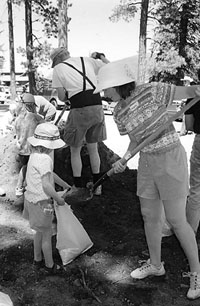|
|
|
||||||||
|
Fire victims are frustrated too. Susan and Robert
Bisinger’s 3-acre lot in the Enchanted Forest subdivision was
burned in the fire but their “But the train will get money – don’t
worry,” she Vallecito resident Shelley Wiese experienced flooding this July “like … a big huge river with rocks.” Like everyone else in La Plata County, she expects
more floods to come. She is concerned because reseeding hasn’t
started on forest service lands above Vallecito, and she feels that
the Road and Bridge Department will be overwhelmed when the monsoons
come. “It’s not like it’s flooding
because it’s been raining for two months,” Wiese said. “I’ve heard of a lot of people that got completely screwed by their insurance companies and then got screwed by FEMA,” Wiese added. “I don’t know anybody who’s getting help from FEMA, not a single person.” FEMA's hands tied Ricardo Zuniga, a public information officer at FEMA’s disaster field office in Denver, said he understands frustrations and that the organization is “limited by law.” He said he encourages people to report mudflow damage to the local Emergency Management Center and to keep receipts of expenses incurred. “In the event of a federal disaster declaration, reimbursement may be possible,” Zuniga said. “It’s not that we don’t understand there’s hardship, but we’re doing the best we can. “We have to balance out the needs of people
in times of disaster with our fiduciary “My personal opinion is that our local elected officials could do more to convince FEMA that there is a need,” Wiese said. For example, she said that after the Cerro Grande fire in Los Alamos, N.M., members of Congress like Rep. Heather Wilson, R-N.M., were “pushing FEMA, saying, ‘These people need help and they need it now.’” “The squeakiest wheel gets the oil,”
she said. “But ‘be quiet and stop whining’ Her father, Joe Bowden of CDS Environmental Services, agrees. “They should be out with an ugly stick beating up Washington on a regular basis,” he said. Alton Dillard, state press secretary for Campbell,
said a request for the declaration But even as they rip into FEMA and politicians,
residents effusively praise the He said this at an event organized by Helping Hands, a community assistance program, was founded by Wanda Sothen during the Valley and Missionary Ridge fires because people wanted to help, and they weren’t being utilized by the other agencies, Sothen said. Helping Hands runs entirely on donations and has helped more than 1,400 people since its inception June 17. Sothen said fire and flood victims seeking help should start by calling Helping Hands. The group then works with the 27 community agencies and churches that are members of the La Plata County Disaster Recovery Coalition to help meet victims’ needs. In contrast, she said, FEMA sends fire victims straight to the SBA for loans before considering them for the “Individual and Family Grant Program.” (The maximum available grant is $14,800.) “Even if they get a loan, most businesses here don’t want to incur additional debt, so that makes it a catch-22 for them,” Wanda said. Of course, the SBA loans are available only to victims of the fire, not floods.“Even if FEMA doesn’t come through, we’ll do it ourselves,” Scearce said. “We’re lucky to be in a place where people are so commnity-minded. The feds can just pack it up and go back to Washington.”
|
|
||||||||
|
 |
||||||||


 Going
to the grassroots
Going
to the grassroots